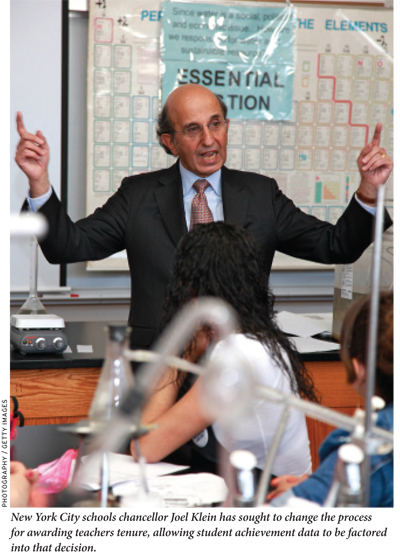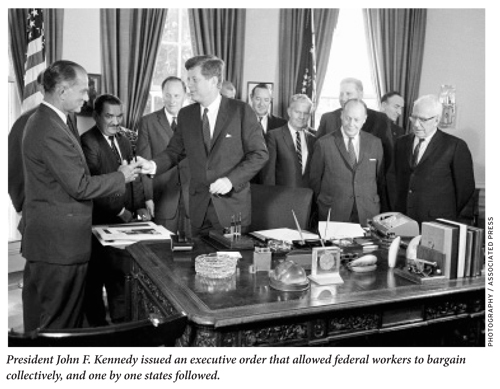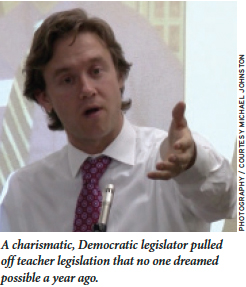Video: Emily Cohen talks with Education Next.
When the Cleveland, Ohio, school board had to make radical cuts in its budget last spring, it was forced to eliminate 540 teaching jobs. There wasn’t a whole lot of mystery about which teachers among Cleveland’s 3,500-member teaching force would be the ones to lose their jobs.
The state’s hard-and-fast seniority rule—last hired, first fired—provided Cleveland school officials with little wiggle room for deciding which teachers had to go. Among the first were a number of teachers who had been handpicked to staff the district’s 10 new “innovation” schools. Ann Mullin, senior program officer for education at Cleveland’s George Gund Foundation, told the city’s Plain Dealer, “There’s something wrong when a state law forces removal of teachers without regard to their effectiveness in the classroom.”
Across the country, many cash-strapped districts fretting over likely layoffs are eyeing seniority rules as they hammer out new contracts. To the surprise of some district superintendents, contract negotiations are not likely to offer much relief. In fact, when it comes to seniority rules, and many other core aspects of teachers’ employment, the contract is not the problem. State law is. In Ohio’s case, state law dictates that teachers on continuing contracts and those with greater seniority should have preference, language that is effectively emulated in 14 other states in the country. While teacher contracts may flesh out the details of school rules and rights of teachers, states are in the driver’s seat. Local control—although it is still brandished when expedient—is today more myth than reality, at least when it comes to matters involving teachers.
The contract certainly still plays a big role in determining a teacher’s pay, work schedule, and benefits, but the power behind the policies with the most impact on teacher quality, such as tenure and performance assessment, lies with states. That power has steadily increased over the decades, especially in recent years, as federal initiatives like No Child Left Behind and Race to the Top have pushed states to assume more authority over education.
What best explains increasing legislative involvement in teacher governance is the rise of teachers unions. The public-sector labor movement took hold in the second half of the 20th century when, in the face of poor working conditions and low wages, unions began lobbying for collective bargaining rights. In 1962, President John F. Kennedy issued an executive order that allowed federal workers to bargain collectively, and one by one states followed, affording unions substantial bargaining power by the mid-1970s.
As unions matured, their leaders realized that it is more efficient to lobby state legislatures on particular workplace provisions than to negotiate the conditions into hundreds of individual contracts. And once the stipulations are passed, there is generally no clock ticking on a law’s expiration as there would be if the provision were part of a collective bargaining agreement.
For a number of reasons, the unions have had considerable success in passing teacher-friendly legislation in spite of frequent opposition from school districts in a state or even the department of education. Because union interests are narrowly defined (unlike, for instance, those of the business community), teachers unions can go after an issue with laserlike focus, and they are quite adept at drawing on the public’s generally supportive view of teachers. Unions are highly effective lobbyists in part because, unlike many advocacy groups, they are membership organizations (for the nation’s largest profession). Whereas other groups typically rely on grants and donations, unions collect a steady stream of income from member dues and are flush with discretionary funds, which can be used to build campaign war chests and contribute to lobbying efforts (see “The Long Reach of Teachers Unions,” features). State union affiliates typically have full-time paid staff devoted to producing a successful outcome from the legislature. In cases of ballot initiatives, unions have a bloc of votes they can count on should they need to press for one outcome or another. Unions are a force that legislators want to cultivate, as much as the unions want to cultivate the legislators. Each ignores the other at its peril.
To see just where union efforts lead in practical terms, one only need look at campaign finance disclosures. The California Teachers Association (CTA), for example, was the state’s largest political spender in the last decade, devoting $212 million to ballot measures, campaigns, and lobbying. It’s no surprise then that during that time, California legislators voted down measures for reforms such as differentiated teacher compensation and the use of student achievement data in teacher evaluations.
Only recently have education advocacy organizations entered the scene, pushing agendas that are distinct from those of the unions, most notably Connecticut’s ConnCAN, Advance Illinois, Florida’s Foundation for Excellence in Education, and various state chapters of Democrats for Education Reform. These groups appear to be a growing force in state legislatures, particularly, though not only, because of the Race to the Top initiative dangling money before states to spur reform. In 2009, ConnCAN had a hand in overhauling teacher certification requirements in Connecticut, securing approval for alternative routes to certification like the Teach For America program, a legislative change fought tooth and nail by the teachers union. No legislative success, however, trumps that achieved in Colorado in May 2010. The perfect storm—a charismatic, Democratic legislator who is a Teach For America alumnus, the lure of Race to the Top funds, and a whole array of advocacy groups that included the Colorado chapters of Democrats for Education Reform and Stand For Children—pulled off teacher legislation that was bitterly opposed by the state union and which no one dreamed possible a year ago.
The involvement by states in teacher employment issues is largely unknown, not just to the general public, but to policymakers themselves. A look at state laws reveals a surprisingly high level of intervention into the most important concerns of teachers:
Evaluations: Although school districts, rather than states, employ teachers, nearly every state has something to say about how and how often teachers must be evaluated. All but eight states determine the minimum frequency of teacher evaluations. Districts technically have the leeway to exceed the minimum set by the state, though they rarely do. The minimum therefore becomes the de facto maximum. Since the announcement of Race to the Top, several states have increased the frequency of evaluations for tenured teachers to at least once a year; 19 states now mandate that all teachers receive a performance review annually.
Many states also decide what the evaluation instrument must look like, or what its components must be, and whether student performance can factor into a teacher’s evaluation rating. Thirty-one states either determine the evaluation instrument a district must use, require state approval for district evaluation instruments, or provide explicit guidance. Twenty-one states now have data systems that match individual teacher records with student records. In a direct effort to compete in Race to the Top, California, Nevada, Indiana, and Wisconsin have eliminated obstacles to using student performance data in teacher evaluations. In California, the law had been in the making since the 1980s, but stalled repeatedly as a result of infighting among state agencies and a lack of political support. According to the Los Angeles Times, “The new bill removed one of the system’s key limitations—it set aside a 2006 state law that, at the insistence of teachers unions, prevented California from using the system to evaluate teachers based on the academic gains of their students.”
Tenure: There are two kinds of teachers: those with tenure (also known as “continuing contract” status) and those without it (those on a “probationary” or “provisional” contract). A veteran teacher with tenure receives preferential treatment over newer teachers in school assignments and with respect to layoffs and dismissal procedures. Tenure may also play a role in how frequently a teacher is evaluated. In Virginia, for example, nontenured teachers are evaluated annually, whereas tenured teachers can expect a performance review every three years.
Tenure is hugely important to teachers. Yet look at any contract and you’ll see that very little is said about it, particularly about the process by which it is conferred. The language isn’t there because states, not districts, decide when teachers should be eligible for tenure. All 50 states have tenure laws, but only about one-third of the largest districts even mention tenure in their contracts.
State laws are responsible for making tenure a relatively automatic milestone, which, depending on the state, is awarded after one year (in Mississippi and Hawaii) or following as many as seven years of service (in Ohio), but most often in only three years. If state laws put any other condition on a teacher’s eligibility for tenure, it is usually a record of satisfactory evaluations, a benchmark that all but a tiny fraction of teachers meet. The New Teacher Project’s recent report, The Widget Effect, noted that in the 12 school districts it examined, less than 1 percent of all teachers had received an unsatisfactory evaluation, even in schools where students were chronically underperforming. Louisiana state law illustrates the relative ease in earning tenure: “Such probationary teacher shall automatically become a regular and permanent teacher in the employ of the school board of the parish or city, as the case may be, in which he has successfully served his three-year probationary term.”
Theoretically, a district can impose a more rigorous tenure requirement than that established by the state, but not without great difficulty. In 2007, New York City schools chancellor Joel Klein sought to change the process for awarding teachers tenure, allowing student data to be factored into that decision. The local teachers union, the United Federation of Teachers (UFT), strongly opposed the change. The UFT took the fight to the state legislature, as state law precluded locals from having any say on tenure matters. Joining forces with the powerful state teachers union, the UFT succeeded in blocking Klein’s tenure changes by embedding a provision in the 2008–09 budget that made it illegal to consider a teacher’s job performance as a factor in the tenure process.
 Compensation: Though school districts negotiate with their unions the exact amount of pay at each step of the salary table, states often decide when teachers receive pay increases and by what criteria. Half of all states have specific salary regulations that school districts must respect. Of those, 17 spell out the terms under which districts must provide teacher raises, including that teachers must be provided a raise if they earn a master’s degree, or two, or even three. The love affair that states have with master’s degrees really cannot be justified, as no study of any repute has ever found that these degrees make teachers more effective, particularly when the degrees are earned in education.
Compensation: Though school districts negotiate with their unions the exact amount of pay at each step of the salary table, states often decide when teachers receive pay increases and by what criteria. Half of all states have specific salary regulations that school districts must respect. Of those, 17 spell out the terms under which districts must provide teacher raises, including that teachers must be provided a raise if they earn a master’s degree, or two, or even three. The love affair that states have with master’s degrees really cannot be justified, as no study of any repute has ever found that these degrees make teachers more effective, particularly when the degrees are earned in education.
Increasingly, states are supporting performance pay initiatives, with the latest tally at 19 states. However, by the time these initiatives make their way down to the individual teacher, the bonuses tend to be on the paltry side. Because wholly new sources of money have to be identified to fund these pay experiments—they cannot draw on the many millions of dollars dedicated to rewarding teachers for master’s degrees—these efforts fail to have much of an impact.
Dismissal: While teacher contracts often lay out the steps a district must take to help a teacher who is struggling, contracts rarely account for those teachers whose performance does not improve, even after they receive additional support and professional development.
States, meanwhile, offer a detailed set of policies for how to handle dismissal. Half of the states set forth specific dismissal procedures, including the number and nature of appeals a teacher or union may file, the compensation a teacher may earn during the appeals process, and whether a teacher is allowed to stay in the classroom during this period. It has been well documented that dismissal procedures are time-intensive, often taking two to three years to complete. California’s dismissal process includes 10 different steps, which perhaps explains why just 100 dismissal hearings were held in the state between 1996 and 2005, according to the California Legislative Analyst’s Office.
Part of the reason these procedures are so complicated is that teachers have rights to appeal that effectively treat the district’s dismissal as a threat to a teacher’s licensure. These laws fail to distinguish between dismissal based on poor performance and dismissal resulting from criminal or moral infractions. Most states allow a teacher to appeal a district’s decision to dismiss at least twice. Washington State goes even further: not only can a teacher appeal a principal’s decision to the local school board; the board’s decision can be appealed all the way to the state supreme court.
Without question, some elements of teacher governance remain the purview of the local district and teachers union. But states play an outsized role in structuring the scope, nature, and specifics of contracts, even before union leaders and school superintendents reach the bargaining table. Enactment of education policy at the state level is a boon for the unions as long as the policy runs in their favor. But the rise of education advocacy groups bears watching, as in some instances they have broken a virtual union monopoly on the policymaking process.
Prior to the flurry of unprecedented activity by states competing for Race to the Top, states’ teacher policies were, on the whole, a mixed bag. Now, even when the legislative goals are relatively progressive, the final language may provide a strong foothold for the status quo. For instance, while Nebraska recently passed a performance pay law, if 75 percent of Nebraska’s school districts do not adopt the plans in their contracts within five years, the law goes away. It will not matter that some districts want to participate. In the 2008–09 school year, Florida state policy required that evidence of student learning be the primary criterion for teacher evaluation, yet 99 percent of all Florida teachers were rated satisfactory. This (and Race to the Top) prompted state legislators to craft an even stricter law that required fully half of a teacher’s evaluation to be based on students’ test performance; the union put up a fight and Governor Charlie Crist vetoed the measure.
Although the legislature is traditionally where policy is enacted, state school chiefs have always had considerable authority—but either they were unaware or not inclined to use it. That may be changing, and nowhere is this development more striking than in Rhode Island. Seventeen years into his tenure but just a few months before retirement, Peter McWalters took on that state’s famously strong union, voiding teachers’ seniority rights in the troubled Providence school district. While the action was widely cheered by reformers, many reformers were also asking why it was so long in coming and why so unique among states. By contrast, current state commissioner of education Deborah Gist has not wasted any time, only a few months into her tenure issuing a directive to superintendents to stop transferring teachers into new jobs on the basis of seniority, mandating instead that vacancies be filled based on a set of performance criteria and on student need. This directive trumps locally bargained contracts and inserts the state into an area long viewed as one that districts and their local unions must work out at the negotiating table.
Superintendents who, like Gist, are directly appointed by a reform-minded governor are more likely to be given the leeway to take bolder stances. Superintendents directly elected by voters, as is the case in 14 states, are probably less likely to take these risks. Still, not only has Gist set an example that other state superintendents can follow, but the promise of Race to the Top has emboldened at least some of the more cautious superintendents. One of the nation’s longest serving school chiefs, Nancy Grasmick, willingly took on the Maryland legislature in order to be more competitive in Race to the Top, using her regulatory power to interpret a new state law on teacher evaluation much differently than the union-friendly legislature intended.
For state superintendents and legislatures, being on the side of reform is no longer such lonely ground on which to stand. They are backed by a growing legion of education advocacy organizations that are proving to be a forceful—and politically savvy—counterweight to the unions. The question is whether states will remain emboldened over the long haul or whether they will back down in the face of union opposition. But given the spate of state reforms this past spring, the future looks considerably more optimistic than even a year ago. State involvement promises to raise standards for the teaching profession to a degree that would be impossible for districts at the bargaining table.
Emily Cohen is district policy director at the National Council on Teacher Quality, of which Kate Walsh is president.
This article appeared in the Fall 2010 issue of Education Next. Suggested citation format:
Cohen, E., and Walsh, K. (2010). Invisible Ink in Teacher Contracts: State policy trumps collective bargaining. Education Next, 10(4), 18-23.






